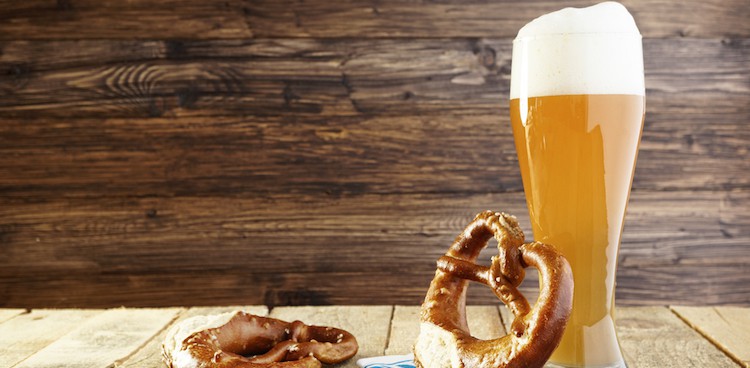
Editor’s note: This post was updated on June 2, 2021.
Nothing warms my heart quite like summer. I pack the months with cheese-and-charcuterie picnics, backyard barbecues, and lazy beach days, often accompanied by my favorite seasonal beer: Germany’s hazy, effervescent, and exceptionally refreshing hefeweizen.
A traditional unfiltered hefeweizen (pronounced HAY-fuh-vite-zen) is made with at least 50 percent wheat. The grain rounds out the beer and supplies both a cloudy hue and a lasting head as lustrous as whipped cream. But the star is Torulaspora delbrueckii, a yeast strain that creates aromas and flavors of banana, clove, green apple, lemon, and bubble gum (the word hefeweizen means “yeast wheat”). Poured into a tall, curvaceous glass, the ale is one of summer’s most beautiful sights.
But hefeweizen is more than just a pretty face—the style has a long, rich history. For centuries, Germany proudly brewed weissbier (“white beer”), a broad category of wheat beers including hefeweizen. But in 1516, Bavarian noblemen instituted the Reinheitsgebot, a law barring brewers from using wheat (instead, the grain was reserved for bakers). Royals, however, couldn’t bear to part with the flavorful suds and granted a weissbier monopoly to the Degenberger brewing family.
By the early 1600s, Bavarian rulers assumed production of weissbier. It remained in demand until the late 1700s, when public tastes shifted to dark lagers and, later, crisp pilsners. Royals relinquished their monopoly in 1872, and the style clung to relevancy throughout the 19th and early 20th centuries. Doctors prescribed weissbier to cure vitamin deficiencies in the elderly and infirm. (Little wonder: The beer bursts with B-complex vitamins.)
By the second half of the 20th century, though, the clouds cleared. Weissbier became increasingly popular in northern Germany (Bavaria sits in the south) as drinkers discovered the easy sipper’s unique bouquet. Today, weissbier is off its deathbed, and hefeweizen is a sensation brewed and poured worldwide. German breweries such as Weihenstephaner, Ayinger, and G. Schneider & Sohn all make excellent hefeweizens, as do American outfits including Sierra Nevada, La Cumbre, and Sly Fox.
Barkeeps often garnish hefeweizens with a lemon slice to cut the wheat flavor. I typically discard the wedge. It’s like dousing a steak with ketchup—why tinker with perfection? And, scientifically speaking, the acid in citrus oils destroys the beer’s head. Still, I’m no killjoy. Squeeze away if you like.
Pairing Notes
A light-bodied hefeweizen is a great friend to fresh cheeses, such as creamy, luscious burrata and mozzarella di bufala, especially with slices of ripe summer tomatoes. Or take it in a different direction: Hefeweizens also find harmony with tangy cheeses like feta or chèvre. Try Vermont Creamery Goats’ Milk Feta and Haystack Mountain’s Haystack Peak, as well as Rawson Brook Farm Monterey Chèvre and Chèvre d’Argental
Five to Try
Star Hill Brewery The Love: Made with wheat-beer yeast from Germany, the Virginia brewery’s golden hefeweizen goes down light and easy, with a fruity nose and crisp, spicy finish.
Sierra Nevada Brewing Company Kellerweis: To intensify this Bavarian-style hefeweizen’s flavor and aroma, brewers use the Old World technique of open fermentation, creating a complex beer with notes of clove and banana bread.
Ayinger Brewery Bräu-Weisse: This German import smells deeply of ripe banana, lemon, and clove. It drinks super-smooth and a touch fruity and tart, before concluding dry and clean.
G. Schneider & Sohn Weisse Tap 7 Unser Original: Since 1872, the Bavarian brewery has specialized in wheat beers like this mahogany-hued hefeweizen. Scented of clove and nutmeg, the full-bodied beer is a study in balance.
Weihenstephaner Hefeweissbier: Reportedly the world’s oldest continually operating brewery (first beer: 1040), the German institution’s centuries of expertise are on full display in this mild refresher with appealing banana flavor.
Feature Photo Credit: Silberkorn | Shutterstock.com





